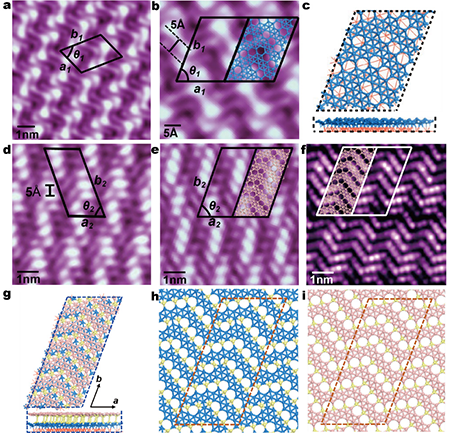| Nov 15, 2021 |
Researchers synthesize bilayer borophene
(Nanowerk News) Boron is the neighboring element of carbon in the periodic table, and has strong bonding capability comparable to carbon. Two-dimensional boron, named borophene, has predicted to have exotic properties beyond graphene, such as mechanical compliance, optical transparency, anisotropic plasmonics, ultrahigh thermal conductance, one-dimensional (1D) nearly-free-electron states, presence of metallic Dirac fermions, and superconductivity.
|
|
A few years ago, monolayer borophene has been grown on metal substrates like Ag(111)/(110)/(100) by two groups including Prof. WU Kehui and Prof. CHEN Lan from the Institute of Physics of the Chinese Academy of Sciences. Compared with monolayer borophene, bilayer borophene is more stable due to the interlayer bonding, and exhibits richer physical properties. However, the bilayer borophene was not thought to be synthesized due to the passivation from metal substrate.
|
|
Dr. CHEN Caiyun led by Prof. WU Kehui and Prof. CHEN Lan, collaborating with Dr. LV Haifeng et al. led by Prof. WU Xiaojun from University of Science and Technology of China, found that the charge transfer from Cu(111) surface to the monolayer borophene were much larger than that on Ag(111) surface.
|
|
According to the researchers, this fact indicates boron atoms on Cu(111) are more activated than that on Ag(111), and may overcome the problem of metal substrate passivation.
|
|
They then realized the synthesis of large-size, single-crystalline bilayer borophene on the Cu(111) surface by molecular beam epitaxy (MBE) (Nature Chemistry, "Synthesis of bilayer borophene").
|
 |
| The STM images and atomic structures of monolayer and bilayer borophene on Cu(111) (Image: Institute of Physics)
|
|
The scanning tunneling microscopy (STM) and first-principles calculations show the bilayer borophene consists of two stacked monolayers. Each monolayer has chain-like structures with zigzag rows, and combined together by covalent interlayer boron-boron bonding.
|
|
The researchers also revealed that the bilayer is metallic and exhibits enhanced chemical stability and anti-oxidation than monolayer.
|
|
The bottom-up synthesis of bilayer borophene sheet provides opportunities and challenges for the characterization of their physical properties. The high quality of bilayer borophene on metal surface and in particular its large size and single-crystalline nature may enable the fabrication of borophene-based devices, such as the proposed ultracapacitor, photonic and plasmonic devices, and electronic biomedical devices with high sensitivity of signal transmission and detection.
|

